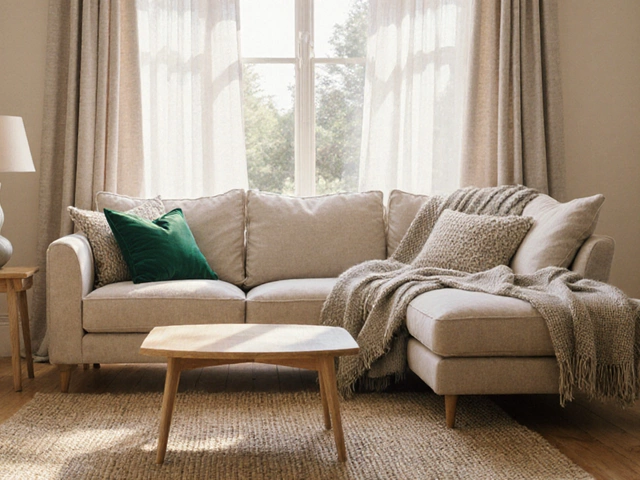You ever walk through a furniture store, spot the sofa of your dreams, and instantly start checking your wallet? Maybe you’re even thinking, “Should I just pay cash for this and be done?” Well, it might surprise you just how much there is to weigh here. Furniture isn’t pocket change, right? Americans spent $129.9 billion on furniture and bedding in 2023 alone. That’s a lot of living rooms getting makeovers! So, is letting go of a big wad of cash a boss move or just something that sounds good in theory? The answer isn’t as obvious as you’d think.
The Real Upside of Paying Cash for Furniture
Let’s be real: there’s a lot to like about paying cash. First, you skip all the interest-hiking, anxiety-inducing trap of borrowing. No loans. No monthly reminders that your new leather sectional is still technically not even yours. Best of all, nobody can knock on your door and take it back if you forget a payment. That sense of finality, man—it’s freeing. You own it, it’s yours, you never think about payments again.
Think about discounts, too. Some shops offer 5%–10% off if you pay cash, since they dodge credit card processing fees (usually 1.5%–3%). It’s worth asking—most folks never do, but you might save a chunk just for being bold. Cash also forces you to stay within budget. A study from MIT found that people tend to spend up to 100% more with credit cards than with cash, partly because handing over physical bills feels more “real” than swiping. With cash, you often second-guess whether you truly need that fancy ottoman.
Another sneaky benefit: you dodge those store credit cards. Sure, they’re tempting with their “zero interest for six months,” but one late payment and you’re suddenly forking over 20% more than you planned.
The Hidden Downsides of Paying Cash
Now, let’s not sugarcoat it—dropping thousands in one go isn’t always smart. First off, you’re instantly less liquid. What if your car dies a week later? That rainy day fund took a hit for a sectional that might not even fit your living room right. Furniture is one of those things that loses value faster than your phone—try reselling a sofa on Facebook Marketplace and you’ll see. So that cash is now furniture.
Cash buyers also lose out on some perks. Credit cards often toss in buyer protection, extended warranties, and even free returns if you hate that new table after a month. If you buy with actual cash, good luck getting help if something’s off, unless the store’s customer service is saint-like. Furniture stores can be sticklers about returns, especially for cash deals—refunds often take days, or worse, they’ll only give store credit.
Don’t forget your credit score. Using cash means missing an easy shot at building credit. Even if you can pay off a credit card bill on time, that positive history doesn’t happen if you use cash. So, if you’re looking to get a mortgage or car loan soon, each opportunity to show you can manage credit helps.
Security matters, too. Ever lost $2,000 cash? If you drop a stack in the food court, it’s gone. Swiped cards can be canceled. Cash? No such luck.

Are There Smart Times to Use Cash?
Let’s get into strategy. Say you’ve been squirreling away cash in your “dream living room” envelope for years—that’s a situation custom-built for a cash furniture run. If you can still keep at least three months’ expenses in your emergency fund after buying, you’re in good shape.
Sometimes, furniture stores run special “cash-only” blowout sales. These usually happen close to fiscal quarter ends, when managers want to boost those numbers. If you catch one of these, you might get jaw-dropping prices. Here’s a tip: even if the sale isn’t labeled “cash-only,” negotiate. Play up your readiness: “If I pay in cash today, can you do any better on price?” You’d be surprised how often managers can knock off delivery or taxes.
Another angle: local businesses. Unlike Big Box chains, independent furniture shops love cash deals. Less paperwork and no card fees mean they’re sometimes more willing to throw in sweeteners—think free assembly, or better quality for the same price.
Also, if you’re trying to avoid debt or are strict about sinking money only into needs, cash-only works like a personal guardrail. It’s hard to get carried away when you literally see bills leaving your hand.
When Financing Furniture Makes More Sense
Here’s the deal—you don’t always need to be a cash purist. There are a few cases where swiping plastic might be the smarter move. If your credit card offers hefty cash-back (say, 5% on furniture for the month), paying off the balance before interest kicks in can actually save you money.
And then there’s the “zero interest” financed offers. These can work if—and this is a big “if”—you are 100% sure you’ll pay off the total before the deadline. Stores run background checks to determine if you qualify, but if you snag a good deal, you basically get a free installment plan. Miss a payment, though, and retroactive interest can get brutal. According to Credit Karma in 2024, almost 42% of consumers who take “zero interest” deals end up paying some interest due to late fees or missed deadlines.
Another time to finance? If a move or emergency caught you off guard and you flatly don’t have a few grand on hand. This doesn’t mean buying a luxury set, but spreading payments over six months for a needed bed or table is way better than emptying your checking account.
Credit cards also give you a paper trail—handy for disputes. If your couch arrives with a mystery stain or broken leg, chargeback options are legally in your favor. Plus, credit usage (as long as you don’t max out your cards!) helps maintain a strong credit profile.

Making Smart Furniture Buys: Expert Tips
Whether you go cash or credit, you want your money’s worth. So, here’s what the pros suggest. Start by measuring your space. Sounds obvious—but more than 1 in 4 sofa buyers in 2022 admitted their new couch didn’t fit their room. Get those dimensions right on your phone before you hand over a penny.
Get quotes in writing. Visit at least three stores. Even if you have your heart set on one spot, a written offer gives you leverage to negotiate a better deal. Don’t rush—the best sales often pop up around national holidays (think July 4th or Thanksgiving), or during end-of-season clearances in January and July.
Ask about floor models. These are display sets—never used at home, but heavily discounted. As of 2024, shoppers saved between 15% and 30% by snagging floor models instead of boxed versions.
If you’re buying cash, always get a detailed receipt and check store policies for returns and warranties. For credit purchases, see if your card offers price protection—some will actually refund you the difference if the item goes on sale shortly after your purchase.
And if you have the time, check out local online marketplaces. Lots of folks post lightly used, almost-new stuff for less than half retail, especially if they’re moving out. Just remember, private sellers are practically never set up for returns, so inspect before handing over any cash.
| Factor | Cash | Credit/Financing |
|---|---|---|
| Instant Ownership | Yes | Delayed if payments ongoing |
| Potential Discounts | 5–10% (if offered) | Rare |
| Fraud Protection | No | Yes |
| Impact on Credit Score | No impact | Positive (if paid on time) |
| Risk of Overspending | Lower | Higher |
| Return/Refund Options | Less flexible | More flexible |
So, should you bust out the cash for that new sectional? There’s no single answer. Do the math, think about your emergency fund, and hit up your trusted furniture expert—or at least your uncle who always seems to get the best deals. Use buy furniture with cash as your north star when searching local deals if you decide cash is the way. The goal isn’t just “new stuff.” It’s making the smartest move for your money and your space. Shop sharp, spend smarter, and your next furniture buy will feel a whole lot sweeter.



